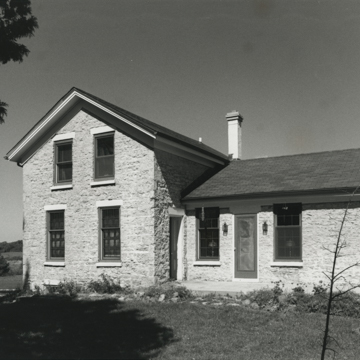In the early 1840s, a group of settlers from Vermont and Maine arrived in the area that became the Town of Rutland. Among them was farmer Sereno W. Graves. As a school-teacher in Vermont, Graves had spent his summers learning stonemasonry. He arrived in Rutland in 1844 and became perhaps the area’s most important nineteenth-century political leader, having held nearly every political office at one time or another. But his longest-lived legacy was the collection of well-crafted limestone buildings he constructed in Rutland, several of which have survived intact.
The most formal is the Sereno Graves House (1846; 4006 Old Stage Road), which bears the distinctive hallmarks of Greek Revival, in particular the raked molding and the cornice returns at the gable ends. It took great skill to form fairly regular courses with irregularly sized limestone rubble and raised mortar joints and to shape openings and square corners with the rubble. Between 1855 and 1861, Graves built the E. Lockwood Barn (Old Stage Road, 0.5 miles west of the Graves House). Like the Graves House, this rectangular two-story bank barn has richly textured walls of irregularly sized rock-faced stone.
Another surviving Graves building is the Daniel Pond House (U.S. 14, 0.5 miles southeast of Biglow Road) built for a prosperous wheat farmer between 1844 and 1850. Set on a hill overlooking the highway, the handsome one-and-a-half-story farmhouse is constructed of rock-faced limestone rubble with raised mortar joints. Stone quoins reinforce the corners and lend an air of formality. Graves added the two wings later. At one time, porches probably sheltered the two wings. The brick chimney is a more recent addition.


